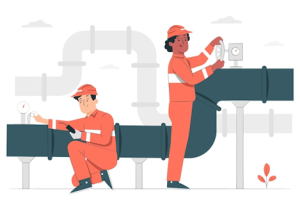
Newco Homes was a group house builder offering house packages and making multiple homes a year. At any point in time, Newco Homes had many houses under construction. These houses would each take three to six months to complete, all going well, and the building of these houses does overlap.
In its environment, Newco Homes was running what we call projects. Newco installed a project time gap, called a buffer. On a house built, Newco Homes would have multiple chains of parallel activity converging over the build duration, each with their own mini buffers. It had two to three of these complex house builds going at the same time.
In the factory, Newco Homes had a project plan up on a visual board, with pieces of string on it, to represent the ‘now’ status. The purpose of this was to help identify where each project was up to, and where they were falling behind. From this visualisation, the team could clearly see when the project started, where each build was up to, and could state how much buffer they had left.

Each project’s time gap, its buffer, represented the build’s ability to absorb delays, termed ‘safety,’ essentially a contingency allowance build into routine operations. If everything went well, a build would finish early. However, there was almost always some form of delay. For example, the weather might go bad and contractors grumble and might be late turning up, so contingency was needed.
The major risk in a house build project is subcontractors, and there are a lot of subcontractors involved in house building, such as the plumber and electrician and, if they are not in-house, the roofer, painters, and fit-out people.

The subcontractors were given dates, but they rarely turned up on those dates. They would ask the builder, “Is it ready for me?” and the builder would reply, “No, it’s another week away, unfortunately.” The subcontractor would then leave the site and go work on a different job. Then, when they finished that job, the subcontractor would come back to the builder. The builder has had that week, plus another week pass by, and they have lost a significant amount of time. Alternatively, the builder would ask “Are you ready to start Monday?” and the subcontractor would reply, “No, I’ve another three days work here to finish up first.”
Newco Homes had its own building team for framing and cladding, and used subcontractors for painting and wiring, etc. Typically, the team installed batts, put the roof on a house, and subcontractors would have done the plumbing, landscaping, and digger work to cut out the base to lay the concrete.

The time gap was an application to protect the delivery performance to the customer. Newco Homes could quote to a customer a date which was the duration of the build, if everything went well, plus contingency, saying, “This is how long it’s going to be,” and could hit it every time. Before this, any quoted date was just a complete guess. Previously, to be competitive in the market, Newco Homes would quote how short it can be, not what was reliable.

While one application of ‘a buffer is a time gap’ is to absorb the variation so a house finishes on time, in a Newco Homes project, there were other builds to consider. This caused key resources’ availability to become limited. If resources were being used on one house, it meant the team couldn’t work on another house, and this was something Newco Homes had to manage.
With many different people, any losses on those subcontractors completing their work rippled through the build in question and into the other builds. For example, if one party was slow to pour the concrete, this meant the plumber putting the piping through the pouring area’s date had passed, and so the plumber starts losing time.

Newco Homes used ‘a buffer is a time gap’ to create reliability. It put a buffer with each of the subcontractors whenever they joined the project. The key was to make sure the subcontractor was on site when required, but meant some subcontractors were standing around doing nothing. Of course, subcontractors don’t want to stand around doing nothing as most have a queue of other projects and other customers to go see.
To overcome this dilemma, a conversation was required. It went something like, “Right, we require you to be here, available, three days before x date! Don’t start anything that will take you longer than that x date.”
The subcontractor was allowed to ask, “Where are we up to?… Good, I can fit a one-day job in,” and go back to it. Yet, the subcontractor wouldn’t start a four-day project as it would burn their time.

Newco Homes needed to add to the time gap conversation and figured out it needed a subcontractor to be on site three days beforehand, saying, “Don’t start anything new, so that you are available when we need you to start.” Newco Homes wanted a rapid handover. In other words, ‘go’ and the subcontractor starts, not ‘go’ and the subcontractor thinks about wrapping up their current job and coming over, plus a few days.

As a result of this, Newco Homes had the subcontractors move to a different commercial relationship, where they were paid from the day they became available. So, if it was in the window of time when they needed to be available, it was, “I’m available, I’m on site, I’m ‘tools down’ doing nothing but I’m being paid.”
Newco Homes experienced that subcontractors who were used a lot were more willing to play. On the other hand, subcontractors that were used for ‘one-offs’ were not interested, saying “I’ve got other stuff to do.”

With ‘a buffer is a time gap,’ Newco Homes found that it could start quoting shorter and shorter project lead times to its customers. What used to be six months, and the industry norm at the time, went down to three months as a reliable build lead time, complete from the ground all the way to the completed house.